Vai al contenuto
1993, two-sided quilt cm 200 x cm 202
Materiali: cotoni tinti a mano in gradazione, sete.
Technique:applique a mano, quilting a mano, ricamo.
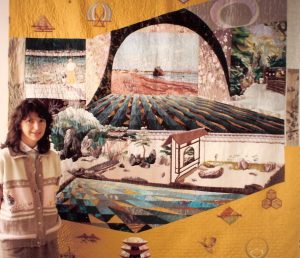
“Un giardino giapponese non è un giardino di fiori: non è fatto nemmeno per la coltivazione delle piante. In nove casi su dieci non c’è nulla che ricorda una distesa di fiori. Alcuni giardini possono contenere appena un ciuffo di verde, altri non hanno niente di verde, e consistono esclusivamente di pietre, sassolini, sabbia…”.
Per comprendere la bellezza di un giardino giapponese, è necessario capire la bellezza delle pietre e ancora:
“Fino a quando non sentirete, e non sentirete a pieno, che le pietre hanno un’anima, che le pietre hanno tonalità e sfumature, il vero significato artistico non vi potrà es-sere rivelato”.
Così Lafcadio Hearn descrive per la prima volta, alla fine del 19-esimo secolo un giardino giapponese in una delle sue innumerevoli composizioni con l’ idea di introdurre in Occidente la cultura e la letteratura del Giappone. Sono venuta a conoscenza di questo scrittore e insegnante di inglese quando ho visitato la sua dimora di Matsue nel corso della mia breve ma intensa visita in Giappone. Ho ritrovato molte analogie con le sue impressioni di viaggio a distanza di più di un secolo!
 In particular I remember visiting the dry-landscape garden Daisen-In in Kyoto and listerning to the explanations given by a monk about the origins of the garden which had been designed about 500 years ago according to the doctrines of the Zen philosophy.
In particular I remember visiting the dry-landscape garden Daisen-In in Kyoto and listerning to the explanations given by a monk about the origins of the garden which had been designed about 500 years ago according to the doctrines of the Zen philosophy.
He explained that the garden is a representation of the cycles of life: a stream(simulated by raked gravel), originates at the waterfalls flowing down with the impetuosity of youth.

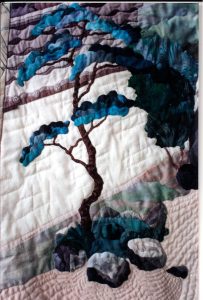
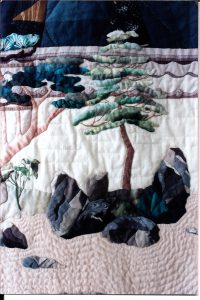 To its right a “turtle islet” and to its left a “crane islet” symbolize the potential depths, respectively heights, of the human spirit.
To its right a “turtle islet” and to its left a “crane islet” symbolize the potential depths, respectively heights, of the human spirit.
Further down the stream, a wall of doubt and contradiction seems to arrest the stream. Yet it goes through it renewed and enriched as symbolized by the “Treasure Ship”. Nearby, a small turtle is helpless in her attempts to swim against the current, representing the human desire to go back in time.
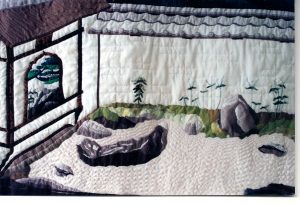
It was only a few months later that I gave more thought to the monk’s explanations: they didn’t seem so simple-minded any more, as I was cutting and appliqueing on fabrics each single rock of the garden, with the intent of respecting its original shape and intrinsic beauty. In fact, it seemed to me that different tones of solid gray would enhance even more the natural changes taking place throughout the journey downstream, while the many tiny pieces of gradating greys appliqued together to form just one stone would add to its reachness and complexity.

The stones were not the only feature of the garden which had caught my attention: for example what to say about those Japanese- style tiles on the roof with a patterned design at the edge? For such details, I definitely enjoyed using embroidery. Even the few plants, scattered here and there throughout the garden, had their own peculiarities with their subdued pale colors, giving way to a scene of an almost ink-style quality.
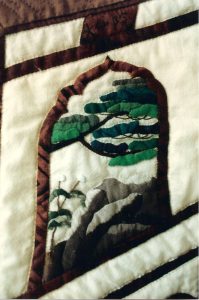
As a next step, it was then only natural to connect those stones to the ones I had actually encountered during my trip to Japan, whether they were simply used as a pavement or awall, scatterred on a beach or amidst the sea at sunset, or hidden between moss in a woodas one may notice, from left to right, looking at the three scenes above the garden.

Like a glimpse on the real windows of life, to me these images capture three different instants in the garden’s journey.
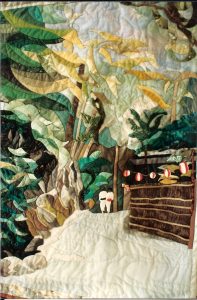
I completed this side of the quilt by adding at its very top and bottom a few decorative Japanese “mons”, the heraldic designs that date back to feudal Japan of the 12th century.
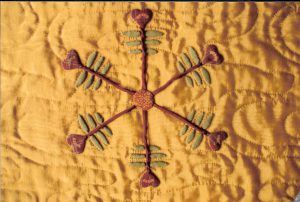
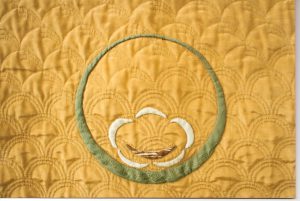

The ones at the top of the quilt represent elements of nature, such as thunder, Mt Fuji, the sun, the moon; at the bottom, on the left side, are the ones dealing with everyday objects (a set of boxes, a fan, the sachè containers) while the mons on the bottom right have a symbolic, spiritual meaning like the turtle or the lotus.
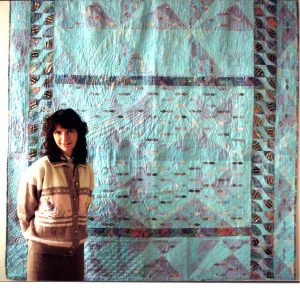
But the garden’s story is not yet finished, its story goes on as retold by the monk: the stream of life ends up in an ocean of nothingness, with just two mounds of sand surronded by raked grave, and no stones at all. We are entering the hidden spiritual side of the garden. I represented my own interpretation of this last part of the garden on the other side of the quilt.
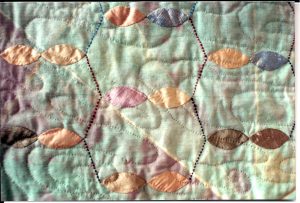
 In particular I remember visiting the dry-landscape garden Daisen-In in Kyoto and listerning to the explanations given by a monk about the origins of the garden which had been designed about 500 years ago according to the doctrines of the Zen philosophy.
In particular I remember visiting the dry-landscape garden Daisen-In in Kyoto and listerning to the explanations given by a monk about the origins of the garden which had been designed about 500 years ago according to the doctrines of the Zen philosophy.
 To its right a “turtle islet” and to its left a “crane islet” symbolize the potential depths, respectively heights, of the human spirit.
To its right a “turtle islet” and to its left a “crane islet” symbolize the potential depths, respectively heights, of the human spirit.












